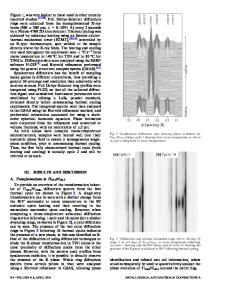Stress evolution in silicon nanowires during electrochemical lithiation using in situ synchrotron X-ray microdiffraction
- PDF / 863,628 Bytes
- 10 Pages / 584.957 x 782.986 pts Page_size
- 26 Downloads / 263 Views
FOCUS ISSUE
PLASTICITY AND FRACTURE AT THE NANOSCALES
Stress evolution in silicon nanowires during electrochemical lithiation using in situ synchrotron X-ray microdiffraction Sasi Kumar Tippabhotla1, Ihor Radchenko1, Camelia V. Stan2, Nobumichi Tamura2, Arief Suriadi Budiman1,a)b) 1
Xtreme Materials Laboratory (XML), Engineering Product Development (EPD) Pillar, Singapore University of Technology and Design (SUTD), Singapore 487373, Singapore Advanced Light Source, Lawrence Berkeley National Laboratory (LBNL), Berkeley, California 94720, USA a) Address all correspondence to this author. e-mail: [email protected] b) This author was an editor of this journal during the review and decision stage. For the JMR policy on review and publication of manuscripts authored by editors, please refer to http://www.mrs.org/editor-manuscripts/. 2
Received: 28 September 2018; accepted: 16 January 2019
Silicon is a promising material for lithium-ion batteries. However, it expands by 300% on lithiation, leading to fracture. Nanostructuring of silicon is expected to be a promising method to improve the mechanical strength of the silicon electrodes. In the present work, a unique battery test cell was designed and fabricated to study the in situ stress evolution in the silicon nanowire (SiNW) electrode during electrochemical lithiation using synchrotron X-ray microdiffraction. The stress in the SiNWs at pristine state and during lithiation was evaluated using energy scans. The average stress in the pristine nanowires was found to be ∼40 MPa tensile, which changed to ∼325 MPa compressive on lithiation. Further, the deviatoric stress state in the SiNWs during lithiation was evaluated using Laue diffraction and the lithiated nanowires were found to be in triaxial stress state with high shear stresses. The technique and the findings provide new and more in-depth understanding of the stress evolution in the SiNWs during electrochemical lithiation.
Introduction Energy storage became an essential requirement in modern electric vehicle systems, portable electronic gadgetry, solar and wind farms, etc. There are several energy storage systems (batteries) available at different sizes and capacities; however, lithium-ion battery (LIB) has been proven to be the most promising candidate because of its several qualities such as high efficiency, high energy density, limited self-discharge, and longer life cycle even with high charging and discharging rates [1, 2, 3], which are important modern battery design parameters. Silicon has a very high charge capacity (4200 mA h/g) theoretically, and it can be a promising replacement for the commercially used graphite electrodes, whose charge capacity (372 mA h/g) is roughly ten times smaller than silicon. It further has a low discharge potential and attractive operating voltage [4, 5]. Along with these benefits, silicon also has a disadvantage, high volumetric expansion (300%) on lithiation [6], leading to high stress, cracking, palletization, and delamination from the current
ª Materials Research
Data Loading...







